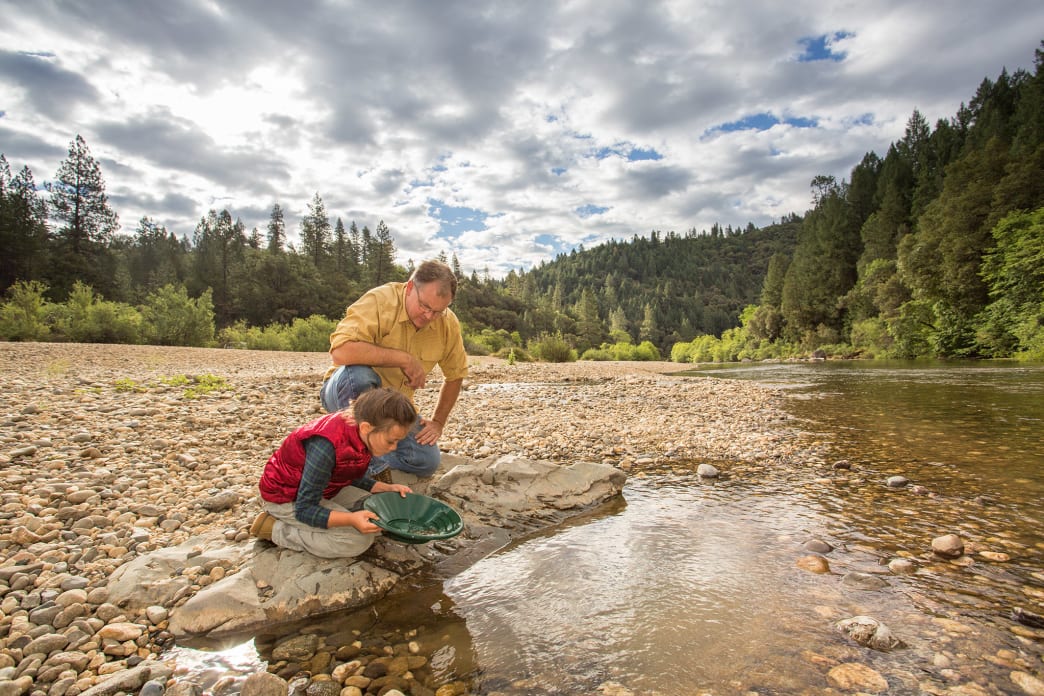The Golden State, the Golden Gate Bridge, the 49ers—we all know that the 19th century Gold Rush brought lasting fame to California, and Placer County was in the center of the boom. Gold was discovered in Auburn Ravine just months after the state’s first eureka moment, which happened right down the road in El Dorado County. Placer County would become one of the top destinations for those who traveled from all over the world to seek their fortune.
The diverse Gold Rush history of the region is yet another highlight that visitors love to explore when visiting the area. From museums to historic sites to places where you can mine for gold, these are the best ways to experience Placer County’s 24-karat history for yourself.
Gold Rush Museum
But in many ways, this museum is far more exciting than those snapshots of the era. Thanks to newly updated interactive exhibits, Auburn’s Gold Rush Museum brings history to life. The centerpiece of the action is the indoor panning stream, where visitors can crouch on their knees and sift through stream’s sand and gravel searching for glittering pieces of gold left in the bottom of the pan. Elsewhere in the museum, a mining tunnel replica shows just how the rock prospectors spent their grueling yet hopeful days.
The museum has also fully embraced some 21st-century elements as well. You can watch tweets go up on the gold rush “Twitter Wall” and pose for selfies with the relics from the miners’ lives. The museum has creatively built a place where whole families can have the experience of a 49er. Admission is free and open hours are from 10:30 am to 4 pm Thursday through Sunday.
Gold Panner Monument
After a trip to the museum, be sure to stop by the Gold Panner Monument in Old Town Auburn. The 45-ton statue represents Claude Chana, the miner who first discovered gold in the Placer County foothills in 1848. Chana is portrayed doing what he’s best known for: panning for that next nugget of gold. It was a local Auburn dentist, Ken Fox, who sculpted the piece for the town in the 1970s. In between dentistry appointments, Fox formed rebar and wire mesh into a frame that he covered in concrete to create the statue. The local artwork depicting a local hero of yesteryear drives home the sense of community and history in this town.
The Joss House Museum and Chinese History Center
Also situated in Auburn, the Joss House Museum and Chinese History Center spotlights yet another fascinating aspect of the California Gold Rush era. The gold prospectors who came to California during this era were not only from other parts of the U.S but from around the world as well—large numbers also came from China, Europe, Latin America, and Australia. The Joss House is a testament to the Chinese settlers who came to Placer County, with original photos, artifacts, and traditional garments and adornments helping to tell the story. The museum is open to the public on the first Saturday of each month from 12 pm to 4 pm in Old Town Auburn.
Placer County Museum
The Golden Drift Museum
Heading north from Auburn up I-80 towards Truckee and Lake Tahoe, the hamlet of Dutch Flat is home to a charming museum of the Gold Rush era. This free-admission museum gets its name from the gold-mining company that was once located in Dutch Flat. The dutifully preserved artifacts on display include mining and railroad equipment, Native American relics, and pieces from the Joss House. The extensive photography collection really shows visitors what the Gold Rush experience in this area was like. The museum is open Friday through Sunday from 12 pm to 4 pm during the summer.
Panning for Gold in Placer County
The original 49ers may no longer be around, but the chance to hunt for gold is still here in Placer County. Start your gold panning adventure at Pioneer Mining Supply in Auburn (open Monday through Saturday in the summer). There, you can get outfitted with everything you need to take to the streams and, if you’re lucky, come back with something shiny. The store stocks power sluices, sluice boxes, and pans, as well as metal detectors and wetsuits for the modern prospector. While you’re there, get the lowdown on the best places to try your hand at gold panning in Placer County, like the Foresthill district, the river channels near Dutch Flat, and the streams by Auburn. You probably won’t get rich (OK, you won’t get rich), but chances are you’ll have a lot of fun.
Written by Jenna Herzog for Matcha in partnership with Visit Placer County.
Featured image provided by Placer County, Erik Bergen


